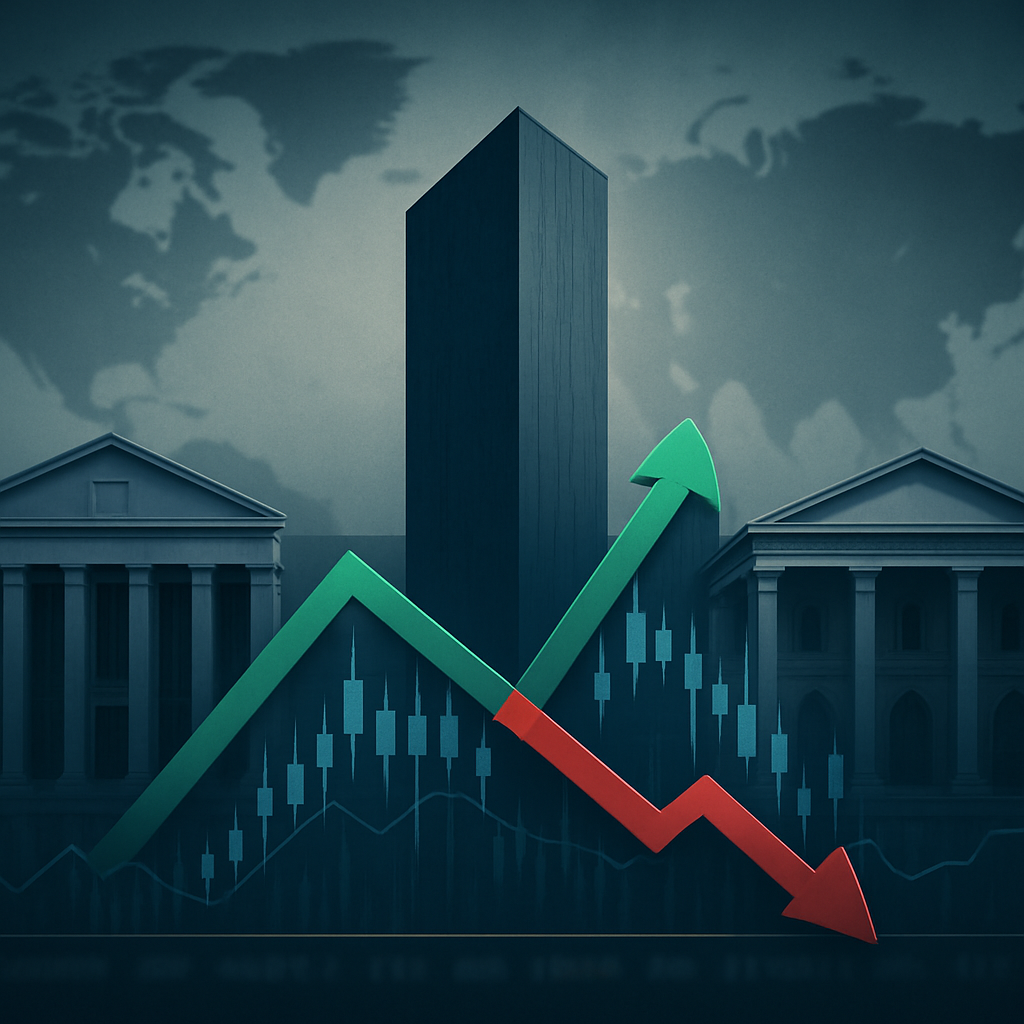
The global financial landscape is bracing for a significant shift as major central banks, including the U.S. Federal Reserve, the European Central Bank, and the Bank of England, signal an anticipated move towards monetary policy easing through interest rate cuts. This pivot, emerging after a period of aggressive tightening to combat inflation, is not entirely synchronized, presenting a complex and often divergent path for global markets. Investors and businesses alike are keenly watching for the coordinated, or indeed uncoordinated, impact of these decisions, which promise to reshape everything from borrowing costs to asset valuations and international trade dynamics.
Central Banks Pivot Amidst Shifting Economic Winds
The current environment sees central banks navigating a delicate balance between tempering inflation and fostering economic growth, often influenced by the unique domestic conditions and the overarching shadow of global trade policies, particularly U.S. tariffs.
The Federal Reserve (Fed), under Chair Jerome Powell, finds itself at a crucial juncture. After holding its federal funds rate target steady at 4.25%-4.50% since December 2024, market expectations are running high for a rate cut to commence in September 2025. Futures markets are pricing in an over 80% chance of a 25-basis-point (bp) reduction, with J.P. Morgan Global Research anticipating three additional cuts into early 2026, targeting a range of 3.25%-3.50%. This expectation is largely driven by a cooling U.S. labor market, with unemployment ticking up to 4.2% in July, and inflation moderating, albeit still slightly above the Fed’s 2% target. Powell's recent remarks at Jackson Hole hinted at the rising threat to growth from persistently restrictive policy, signaling the Fed's data-dependent readiness to adjust. However, some analysts, including Morgan Stanley, caution that the odds of a September cut might be closer to 50-50 given robust economic indicators and core inflation (Core Personal Consumption Expenditures at 2.7% year-over-year in May) resisting a rapid decline. Shares and bonds saw sharp increases following Powell’s signals, and the U.S. dollar is expected to weaken further, having already recorded its largest six-month decline since 1973 in the first half of 2025.
Across the Atlantic, the European Central Bank (ECB) has been more proactive. Having initiated its rate-cutting cycle in March 2025 and following up with reductions in May, the ECB's key deposit rate now stands at 2.0% as of July 2025—halved from 4% in just over a year. While the ECB paused its easing in July, market participants anticipate at least one more 25-bp cut by year-end, most likely in September, to around 1.70%. This dovish stance is influenced by sluggish Eurozone growth (Q4 GDP stagnating at 0.0%) and core inflation near the 2% target, despite lingering wage and supply chain pressures noted by ECB President Christine Lagarde. Euro-area assets have gained appeal amidst this easing.
The Bank of England (BoE) has also joined the easing trend, cutting its Bank Rate to 4% in August 2025, marking the fifth reduction in a year since easing began in August 2024. City forecasters widely expected this move, and markets are pricing in two more cuts by the end of 2025, potentially bringing the base rate to 3.75%. However, sticky services inflation, hovering around 5%, and strong wage growth are constraining the BoE, with some forecasts, like Investec, maintaining a 3.75% rate by year-end, while others suggest it might remain at 4% for the foreseeable future. The BoE describes its approach as "gradual and careful," heavily dependent on evolving economic conditions, particularly in the jobs market, and the significant impact of U.S. trade policy on UK inflation and growth.
This period is marked by a nuanced coordination. While the ECB and BoE have moved to cut rates, the Fed’s anticipated easing is somewhat "out of step" with some other major central banks, creating divergent global monetary policies. This divergence amplifies cross-border volatility and fuels capital reallocation, making resilient sectors and diversified, geographically hedged portfolios crucial for investors.
Who Wins and Who Loses from the Easing Cycle
The anticipated global interest rate cuts are set to reconfigure the financial fortunes of various industries and public companies. While lower borrowing costs generally stimulate economic activity, the impact is far from uniform, creating clear winners and potential losers.
The Winners:
- Real Estate and Home Construction: Lower interest rates directly translate to cheaper mortgages, making homeownership more accessible and boosting demand. This benefits home construction companies like Builders FirstSource (NASDAQ: BLDR) and Mohawk Industries (NYSE: MHK), as well as Real Estate Investment Trusts (REITs), which rely heavily on debt financing for expansion and improved dividend payouts.
- Technology Sector: High-growth tech companies, especially those with significant capital expenditure or R&D needs, thrive on cheaper borrowing. Lower rates reduce the discount rate applied to future cash flows, leading to higher valuations. Giants like Amazon (NASDAQ: AMZN) and Apple (NASDAQ: AAPL), which historically leverage low-cost capital for growth, stand to benefit. The broader tech sector, including companies investing in AI and data centers, will also see increased investment.
- Consumer Discretionary: Cheaper credit and potentially increased disposable income encourage consumers to spend on non-essential goods and services. Companies in this sector, such as Crocs, Inc. (NASDAQ: CROX), Royal Caribbean Cruises Ltd. (NYSE: RCL), and retailers like Target (NYSE: TGT), could see a boost in sales. Big players like Netflix (NASDAQ: NFLX) and The Walt Disney Company (NYSE: DIS) also fall into this category, benefiting from robust consumer spending.
- Industrials: Capital-intensive industries involved in infrastructure and large construction projects will see reduced financing costs. Construction equipment manufacturers like Caterpillar (NYSE: CAT) are direct beneficiaries of increased activity.
- Small-Cap Stocks: Smaller companies are often more sensitive to interest rate changes due to higher floating-rate debt. They tend to outperform in rate-cut cycles as their interest expenses decrease significantly. The Russell 2000 index, representing small-cap stocks, is expected to receive a boost.
- Utilities: These capital-intensive businesses heavily rely on borrowing for infrastructure projects. Lower rates reduce their financing costs, improve margins, and can support higher dividend payouts, making them attractive to income-focused investors. U.S. electricity and power generation companies such as Vistra Energy (NYSE: VST), Public Service Enterprise Group (NYSE: PEG), and NRG Energy (NYSE: NRG) could see strong performance.
- Commodities: As the cost of capital declines and global demand potentially grows, prices for raw materials like oil and industrial metals could rise. Gold and other precious metals often perform well in rate-cutting environments due to lower opportunity costs of holding non-yielding assets and potential currency debasement concerns.
The Losers:
- Financials (Banks and Traditional Lenders): Banks typically see their net interest margins (NIMs)—the spread between interest earned on loans and paid on deposits—compress during easing cycles, reducing profitability. While lower rates might stimulate loan demand and reduce defaults, the overall impact on bank profitability can be challenging.
- Insurance Sector: Insurance companies, especially those with long-duration liabilities, can be negatively affected as lower rates reduce the present value of future cash flows, impacting their profitability.
- Companies with Large Cash Holdings: Businesses that generate substantial interest income from their cash reserves will see this income diminish as rates fall, necessitating alternative strategies to maintain profitability.
Broader Implications and Historical Echoes
The anticipated global interest rate easing cycle is more than just a financial adjustment; it represents a significant reorientation of economic priorities with wide-ranging implications across industries, competitive landscapes, and regulatory frameworks. This shift is rooted in the imperative to stimulate growth as inflation gradually normalizes, though the path ahead is fraught with both opportunities and historical warnings.
Firstly, the easing cycle reinforces a broader industry trend towards renewed investment and consumption. Lower borrowing costs unlock capital for businesses to pursue delayed projects, innovate, and expand, particularly benefiting highly leveraged companies and growth-oriented sectors. For instance, the automotive industry (e.g., General Motors (NYSE: GM), Ford (NYSE: F)) and large industrial players like Airbus (EPA: AIR) and BMW (ETR: BMW) could see stronger demand and cheaper financing for new ventures, strengthening their global market positions. However, the financial sector, especially banks, faces the double-edged sword of potentially increased lending volumes against compressed net interest margins, pushing them towards non-interest income sources and efficiency drives.
The ripple effects on competitors and partners are multifaceted. A potentially weaker U.S. dollar, a common outcome of Fed easing, makes U.S. exports more competitive internationally but simultaneously raises import costs for U.S. companies reliant on foreign components. This dynamic influences global trade balances and corporate supply chain strategies. Furthermore, capital flows into emerging markets (EMs) are a classic consequence of Fed easing, as investors seek higher yields, potentially boosting EM asset prices and providing a lifeline for their policymakers. This influx of capital can also intensify competition within industries globally as cheaper financing becomes more accessible, fostering private sector growth and innovation.
From a regulatory standpoint, the easing cycle presents a critical challenge for central banks and financial watchdogs. While interest rate cuts are designed to stimulate, there's an inherent risk of building up financial fragilities if not managed carefully. Historically, prolonged periods of low interest rates have incentivized excessive leverage and inflated asset valuations, as seen leading up to the 2008 financial crisis. Regulators must ensure financial sector resilience is maintained, not compromised, by a search for yield. The effectiveness of rate cuts also hinges on the "transmission" mechanism—ensuring banks pass on reduced rates to consumers and businesses, often requiring robust regulatory oversight.
Historical precedents offer invaluable lessons. Rate-cutting cycles by the U.S. Federal Reserve since 1981 have, on average, spanned 16 months with significant reductions, demonstrating central banks' commitment to stability. However, equity market performance during these cycles is heavily dependent on whether a recession is avoided; U.S. stocks gained an average of 16.2% when a recession was sidestepped but plummeted -22.9% when one occurred. The post-2008 era, where the Fed kept rates near zero for seven years, led to a "reach for yield" and inflated asset valuations. The current 2020-2024 cycle has been unprecedented in its rapid pivot from easing to tightening and then to a prolonged holding pattern, with global shocks playing a more prominent role than ever. The delicate balance remains: stimulate without reigniting inflation, a lesson from past failures in taming price pressures.
What Comes Next: Navigating the New Monetary Landscape
As global central banks embark on, or continue, their paths toward monetary easing, the coming months and years promise a dynamic and potentially volatile economic environment, demanding strategic foresight from both businesses and investors.
In the short-term (late 2024-2025), the narrative will be dominated by the timing and pace of rate cuts. While the ECB, BoE, and others have either begun or are expected to cut rates, the Fed's decision in September 2025 is a pivotal moment. A cut by the Fed, followed by others, could provide a much-needed boost to global liquidity and risk appetite, potentially propelling equity markets further. However, if inflation proves more stubborn, or economic resilience in the U.S. holds stronger than anticipated, delays or slower easing could lead to market disappointment and increased volatility. For businesses, cheaper financing could unlock deferred capital expenditure and M&A activity, but CEOs should remain cautious, as regulatory scrutiny might limit immediate credit access from traditional banks, making alternative lenders crucial.
The long-term outlook (beyond 2025) suggests a gradual return to a "neutral rate" for many central banks, a level that neither stimulates nor constrains economic activity. Morningstar projects Fed rate cuts through 2027, potentially bringing the federal funds rate to 2.25%-2.50% by 2028. This extended period of lower rates could lead to higher global asset prices, but also carries the risk of renewed inflationary pressures and mounting financial fragilities, such as elevated asset valuations and increased debt, if not carefully managed. Businesses will need flexible, phased expansion plans, while investors should prepare for continued yield compression in fixed income and a hunt for higher risk-adjusted returns in equities and alternative assets.
Strategic pivots are crucial. Businesses must optimize liquidity management, exploring private credit funds and fintech lenders as traditional bank credit may remain tight. Diversifying supply chains and considering reshoring are becoming increasingly viable options amidst geopolitical uncertainties and tariffs. Investors should re-evaluate portfolio construction, diversifying across asset classes and potentially overweighting rate-sensitive sectors. Small-cap equities, housing (homebuilders like Lennar Corporation (NYSE: LEN), D.R. Horton (NYSE: DHI)), technology (AI, cloud infrastructure), energy, and commodities like gold and copper are poised for growth. Even cryptocurrencies are seen by some as potential beneficiaries, acting as both a safe haven and high-yield option in a lower-rate environment.
Market opportunities include economic stimulation, higher asset prices across stocks and bonds, increased liquidity, and capital inflows to emerging markets. However, challenges and risks abound: a potential resurgence of inflation if cuts are premature, amplified market volatility if central bank actions diverge from expectations, and the looming threat of financial instability from asset price bubbles fueled by extended low rates. Geopolitical uncertainties and trade tensions remain significant wildcards, capable of altering economic trajectories and central bank decisions, demanding constant re-evaluation of strategies.
Potential scenarios range from a "soft landing"—a gradual, well-managed easing bringing stability and growth—to delayed easing due to stubborn inflation, an inflation resurgence forcing central banks to reverse course, or a financial fragility scenario where low rates lead to excessive risk-taking and asset bubbles. Geopolitical shocks could also trigger sudden market sell-offs. The coming period requires agility and careful navigation of these complex possibilities.
Conclusion: A Delicate Balance in an Unpredictable World
The anticipated global central bank interest rate easing cycle marks a pivotal moment in financial history, driven by a complex interplay of moderating inflation, varying economic growth trajectories, and the pervasive influence of global trade policies. This shift from an era of aggressive tightening offers a cautious reprieve, designed to stimulate economic activity and reduce borrowing costs, yet it is far from a universally synchronized or straightforward endeavor.
A key takeaway is the nuanced divergence among major central banks. While the ECB and Bank of England have already embarked on their easing paths, the U.S. Federal Reserve's anticipated September cut remains a significant, yet not entirely certain, event. The impact of U.S. tariffs, in particular, is causing a split in global monetary policy, forcing some central banks to cut rates to counteract slowing growth and disinflation, while others, like the Bank of Japan, remain an outlier, even considering future hikes.
Looking ahead, markets will be characterized by both opportunity and caution. Equities, particularly growth-oriented and rate-sensitive sectors like technology and real estate, could benefit from cheaper financing and improved valuations. Fixed-income assets are also expected to perform well as existing higher-yield bonds become more attractive. The U.S. dollar is likely to weaken under aggressive Fed easing, benefiting emerging markets and U.S. exporters. However, investors must remain vigilant. The primary long-term risk is a resurgence of inflation if central banks cut rates prematurely or too aggressively, forcing a potential reversal of policy. Financial stability concerns also linger, as prolonged low rates can contribute to asset price bubbles and excessive risk-taking, echoing lessons from past crises. Geopolitical tensions and trade disputes will continue to add layers of unpredictability, demanding constant re-evaluation of strategies.
Ultimately, the significance of this easing cycle lies in its attempt to steer the global economy towards a soft landing after a turbulent period. Its lasting impact will depend on the ability of central banks to maintain a delicate balance between fostering growth and controlling inflation, all while navigating an increasingly interconnected and unpredictable geopolitical landscape. Investors should closely watch key economic data—inflation, employment, and GDP—alongside central bank communications and geopolitical developments. Diversification, selective investments in quality companies, and a keen eye on currency movements will be paramount in the coming months, as the world adjusts to this new, more accommodative, monetary environment.





